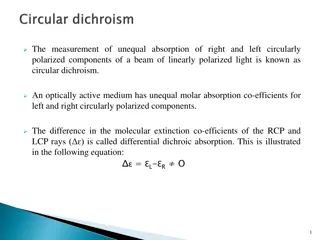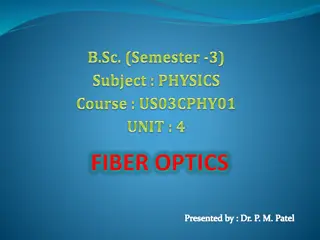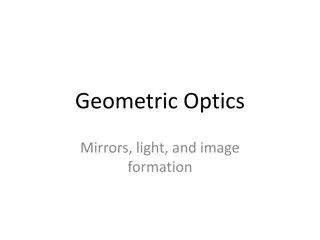Optical Image Formation: Principles and Conditions
Understanding the principles and conditions governing optical image formation, including the role of broad bundles of rays, wave surfaces, magnification ratios, and axially-symmetric optical systems. Explore the conditions for imaging line segments, optical path lengths, and the general criteria for image formation in various scenarios.
Download Presentation

Please find below an Image/Link to download the presentation.
The content on the website is provided AS IS for your information and personal use only. It may not be sold, licensed, or shared on other websites without obtaining consent from the author. Download presentation by click this link. If you encounter any issues during the download, it is possible that the publisher has removed the file from their server.
E N D
Presentation Transcript
Image formation with broad bundles of rays LL2 section 57
Image formation with broad bundles of rays is only possible for special optical systems Suppose all rays starting from O that travel through the optical system intersect again at O . Wave surfaces near O for rays passing through O are spheres. Same for O . Wave surfaces are surfaces of constant phase. The change in phase along different rays between points of intersection with two given wave surfaces is the same. The total change in phasebetween the points O and O is the same for the different rays. The optical path length is the same for all these rays.
Conditions for imaging a line segment using broad beams. Optical path length of all rays that start from O and end at O . (not the same measured from principal points as in sec 56.) and axes need not be parallel to each other or to the optical axis.
Magnification Ratio of length elements for image and object. Constant along a sufficiently small line element Negative cosine of angle between direction of ray and x axis. (see (55.2) and following.
The optical path length + d for all rays starting from point d and arriving at point d must be the same. This is the condition that the paths of rays in the optical system must satisfy to have image formation for a small line segment using broad beams. It must be fulfilled for all rays staring from O.
Image formation by axially-symmetric optical system. Take object to be a line segment on the optical axis. Image is also on optical axis by axial symmetry. A ray approaching the optical system along the optical axis has nx = 1. Afterwards, nx = 1 by symmetry, i.e. it is undeflected.
For these rays General condition of image formation A specific direction of line segment Specific case of axial symmetry
Next consider perpendicular line segment. Line segment dr Image is also perpendicular to the axis. Object is a small portion of a plane perpendicular to the optical axis.
For arbitrary segment dy in plane to be imaged, General condition for imaging For specific line segment perpendicular to optical axis.
Rays emerging from intersection of object plane with optical axis with = 0 are undeflected due to assumed axial symmetry: = 0. Then for non-zero angles, the condition for imaging of transverse planes is
Imaging of 3D object using broad beams is impossible even for small volumes because the conditions for longitudinal and transverse imaging are incompatible.























